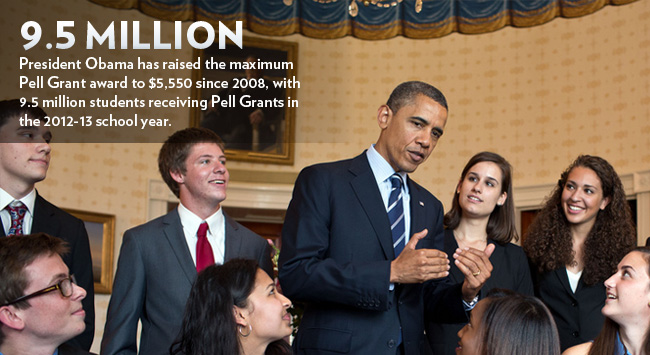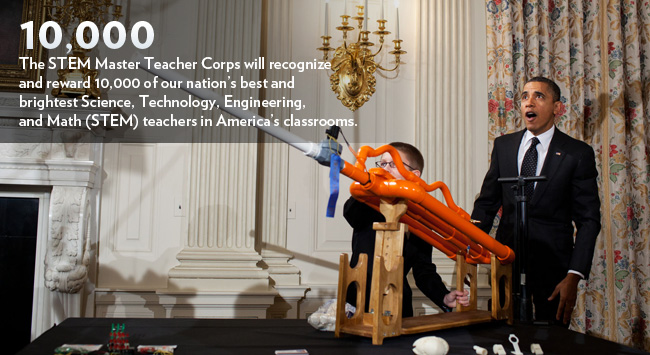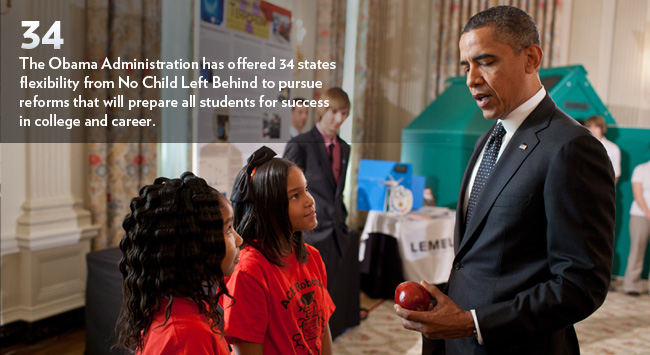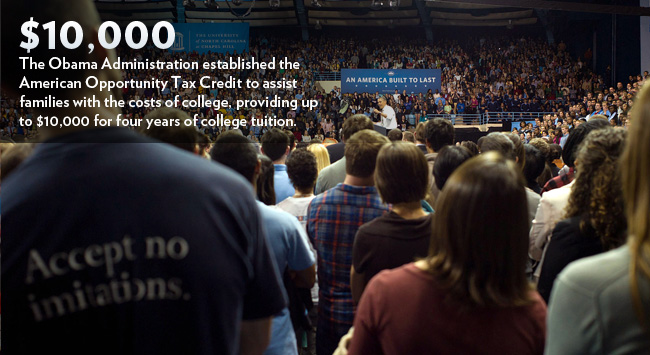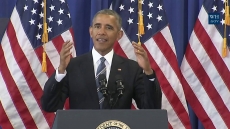EDUCATION
“If we want America to lead in the 21st century, nothing is more important than giving everyone the best education possible — from the day they start preschool to the day they start their career.”
K-12 Education
In today’s global economy, a high-quality education is no longer just a pathway to opportunity—it is a prerequisite for success. Because economic progress and educational achievement are inextricably linked, educating every American student to graduate from high school prepared for college and for a career is a national imperative. The President has articulated a goal for America to once again lead the world in college completion by the year 2020, and all of President Obama’s education efforts aim toward this overarching objective.
To create an economy built to last, we need to provide every student with a complete and competitive education that will enable them to succeed in a global economy based on knowledge and innovation. President Obama has advanced reforms around four key objectives:
- Higher standards and better assessments that will prepare students to succeed in college and the workplace
- Ambitious efforts to recruit, prepare, develop, and advance effective teachers and principals, especially in the classrooms where they are most needed
- Smarter data systems to measure student growth and success, and help educators improve teaching and learning
- New attention and a national effort to turn around our lowest-achieving schools.
Since taking office, the Obama Administration has designed and implemented several initiatives to strengthen public education for students in every community nationwide:
Race to the Top

Race to the Top marks a historic moment in American education. This initiative offers bold incentives to states willing to spur systemic reform to improve teaching and learning in America’s schools. Race to the Top has ushered in significant change in our education system, particularly in raising standards and aligning policies and structures to the goal of college and career readiness. Race to the Top has helped drive states nationwide to pursue higher standards, improve teacher effectiveness, use data effectively in the classroom, and adopt new strategies to help struggling schools.
Redesigning and Reforming No Child Left Behind

As states move forward with education reforms, some provisions of No Child Left Behind — the most current version of the Elementary and Secondary Education Act, which is five years overdue for reauthorization — stand in the way of their progress. Although NCLB started a national conversation about student achievement, unintended consequences of NCLB have reinforced the wrong behaviors in attempting to strengthen public education. NCLB has created incentives for states to lower their standards; emphasized punishing failure over rewarding success; focused on absolute scores, rather than recognizing growth and progress; and prescribed a pass-fail, one-size-fits-all series of interventions for schools that miss their goals.
In March of 2010, the Obama Administration sent Congress a Blueprint for Reform of the Elementary and Secondary Education Act, addressing the issues created by No Child Left Behind while pursuing high standards and closing the achievement gap. But because Congress has not acted to reauthorize ESEA, the Administration moved forward in providing states flexibility within the law – as authorized by provisions in the law itself – to pursue comprehensive plans to improve educational outcomes for all students, close achievement gaps, and improve the quality of teaching. To date, 41 states, CORE (California Office to Reform Education) Districts, and the District of Columbia have received ESEA flexibility.
Redesigning America's High Schools

President Obama's High School Redesign initiative will encourage America's school districts and their partners to use existing federal, state and local resources to transform the high school experience for America's youth through a whole school redesign effort. This effort will challenge high schools and their partners to rethink teaching and learning and put in place learning models that are rigorous, relevant, and better focused on real-world experiences. These reforms will incorporate personalized learning and career and college exploration and ensure that all students graduate with college-level coursework or college credit, as well as with career-related experiences or competencies.
Keeping Teachers in the Classroom

President Obama believes that our children cannot win the future if teachers are not where they belong—in our classrooms, teaching our nation’s children. America’s education system has always been one of our greatest sources of strength and global economic competitiveness, as well as an engine of progress in science, technology and the arts. Our nation cannot expect to train our children for the high-skilled jobs of today, or for the opportunities of the future, without investments in a world-class education system. And America cannot build a world-class education system without teachers in our classrooms.
But cuts to education budgets nationwide put education jobs at risk. These cuts force states and districts into difficult decisions, including laying off teachers and other school personnel, overcrowding classrooms, reducing preschool and kindergarten programs, or even shortening the school week and year.
That’s why the President has invested in education, providing funding to keep hundreds of thousands of teachers on the job over the past three years and creating a proposal to prevent further layoffs from taking place:
In 2009, the President effectively deployed stabilization funds for state education budgets through the American Recovery and Reinvestment Act, which enabled states and schools districts to keep approximately 300,000 educators on the job in the face of budget cuts caused by the economic recession. In 2010, the President signed the Education Jobs Bill into law that provided states $10 billion in emergency funding to keep approximately 130,000 educators in the classroom.
ConnectED Initiative
![]()
President Obama’s ConnectED initiative will enrich K-12 education for America’s students by providing teachers with the best technology and the training to make the most of it, and empowering students through individualized learning and rich, digital content. Preparing our students with the skills they need to get good jobs and compete with other countries relies increasingly on interactive, personalized learning experiences driven by new technology.
ConnectED is built atop the President’s challenge to connect 99% of American students in their classrooms and libraries with next-generation broadband and wireless connectivity within five years. He has also called on businesses, states, districts, schools, and communities to come together in support of this vision of next-generation classrooms, better able to meet the needs of competition in a global economy.
In the first year since the President announced the ConnectED initiative, private-sector companies have committed to provide schools across the country with more than $2 billion worth of free hardware, software, educational content, and wireless connectivity. And the FCC has pledged to invest an additional $2 billion to connect 20 million more students to fast broadband and wireless in their classrooms, over the next two years, as a down-payment on meeting the President’s “99-in-5” connectivity goal.
